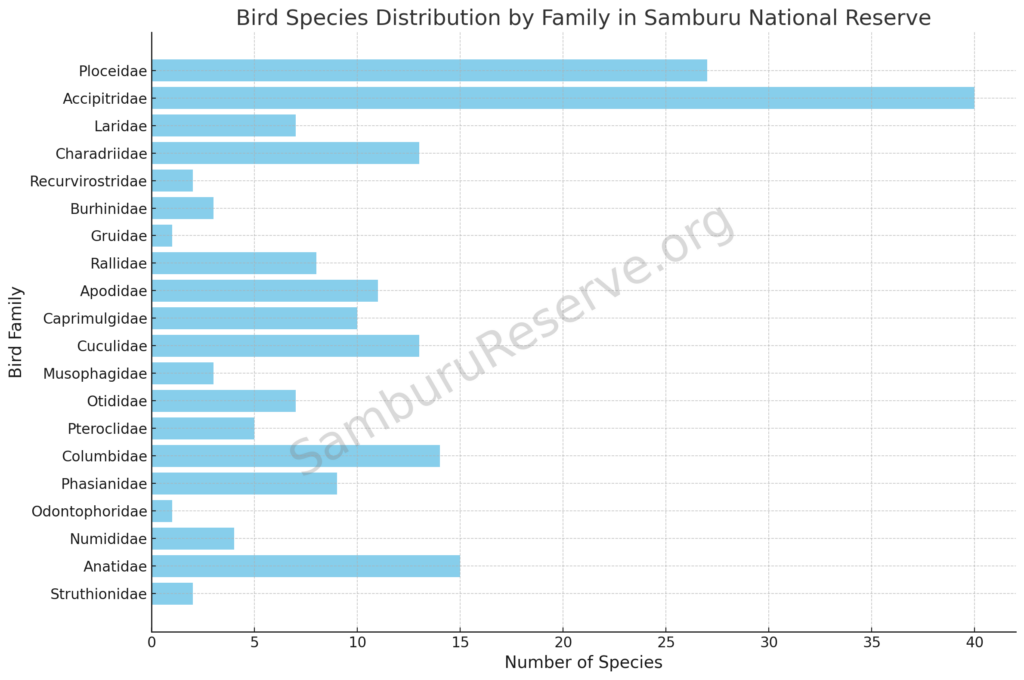Explore the incredible avian diversity of Samburu National Reserve, where over 689 bird species thrive amidst arid landscapes, riverine forests, and savannah plains.
Introduction: Samburu is a Birdwatcher’s Paradise
Located in northern Kenya, Samburu National Reserve is more than just a haven for large mammals—it’s a birdwatching paradise. With 689 recorded bird species, Samburu offers an extraordinary variety of birds, from colorful bee-eaters and majestic raptors to rare species found only in northern Kenya.
📊 Quick Facts About Samburu Birds:
- Total Species: 689
- Globally Threatened Species: 29
- Introduced Species: 3
- Endemic Species: None (though region-specific species are present)
- Best Time to Visit: November to April (breeding season & migratory species)
Overview of Birds in Samburu National Reserve:
According to Avibase, Samburu National Reserve is home to an impressive 689 bird species, representing a rich tapestry of avian biodiversity across multiple bird families. This remarkable diversity is shaped by Samburu’s unique ecosystem, which spans arid savannahs, acacia woodlands, and the life-sustaining Ewaso Ng’iro River.
The most common bird families in the reserve include Accipitridae (eagles, hawks, and vultures), known for iconic raptors such as the Martial Eagle, Bateleur, and critically endangered White-backed Vulture. The Ploceidae family (weavers and allies) adds bursts of color and intricate artistry with species like the Speke’s Weaver and White-headed Buffalo-Weaver, renowned for their elaborate nesting structures.
Other prominent families include Columbidae (pigeons and doves), Anatidae (ducks, geese, and swans), and Meropidae (bee-eaters), represented by the dazzling Northern Carmine Bee-eater and the agile White-throated Bee-eater.
Samburu’s birdlife showcases an extraordinary range—from majestic raptors soaring above rocky outcrops to delicate sunbirds flitting among flowering acacias. The reserve’s mosaic of habitats supports both resident species and migratory visitors, especially during the wet season (November to April) when Palearctic migrants flock to the region.
This diversity not only underscores Samburu’s ecological significance but also cements its reputation as a premier birdwatching destination in East Africa, attracting ornithologists and bird enthusiasts from around the globe.
Whether observing the vibrant Vulturine Guineafowl scuttling through scrublands or spotting elusive species like the Golden Pipit, Samburu offers an unrivaled avian spectacle that reflects the heart of Kenya’s wild beauty.

🗂️ 6 Key Bird Families Found in Samburu
1️⃣ Struthioniformes: Struthionidae (Ostriches)
- Common Ostrich (Struthio camelus)
- Somali Ostrich (Struthio molybdophanes) – Vulnerable
2️⃣ Anseriformes: Anatidae (Ducks, Geese, Swans)
- White-faced Whistling-Duck (Dendrocygna viduata)
- Egyptian Goose (Alopochen aegyptiaca)
- Knob-billed Duck (Sarkidiornis melanotos)
3️⃣ Galliformes: Phasianidae (Guineafowl, Francolins)
- Vulturine Guineafowl (Acryllium vulturinum)
- Helmeted Guineafowl (Numida meleagris)
- Crested Francolin (Dendroperdix sephaena)
4️⃣ Accipitriformes: Accipitridae (Eagles, Hawks, Vultures)
- Martial Eagle (Polemaetus bellicosus) – Endangered
- Bateleur (Terathopius ecaudatus) – Endangered
- Secretarybird (Sagittarius serpentarius) – Endangered
- White-backed Vulture (Gyps africanus) – Critically Endangered
5️⃣ Coraciiformes: Coraciidae (Rollers), Meropidae (Bee-eaters)
- Lilac-breasted Roller (Coracias caudatus)
- Northern Carmine Bee-eater (Merops nubicus)
- White-throated Bee-eater (Merops albicollis)
6️⃣ Charadriiformes: Recurvirostridae, Scolopacidae (Waders, Sandpipers)
- Black-winged Stilt (Himantopus himantopus)
- Common Sandpiper (Actitis hypoleucos)
- Three-banded Plover (Charadrius tricollaris)
Guide to Birds in Samburu Reserve
Samburu National Reserve is a haven for bird enthusiasts, hosting over 689 bird species. This diverse birdlife thrives across various habitats, from the Ewaso Ng’iro River to arid savannahs and rocky outcrops. Here’s a detailed overview of the key bird families you can encounter during your safari.
1️⃣ Struthionidae (Ostriches)
Somali Ostrich (Struthio molybdophanes)
The Somali Ostrich is a large, flightless bird, reaching up to 2.7 meters (9 feet) in height and weighing around 150 kg (330 lbs). Unlike the common ostrich, it has distinctive blue-grey skin on its neck and thighs, particularly vivid in males during the breeding season. Its feathers are coarse and black with white plumes on the wings and tail. The Somali Ostrich thrives in Samburu’s arid landscapes, where it grazes on seeds, shrubs, and grasses. Known for its speed, it can sprint up to 70 km/h (43 mph) to escape predators like lions and cheetahs.
2️⃣ Anatidae (Ducks, Geese, and Swans)
Egyptian Goose (Alopochen aegyptiaca)
The Egyptian Goose is a striking bird with chestnut-colored eye patches, a pale belly, and grayish-brown wings highlighted by a white patch. It stands around 63–73 cm tall (25–29 inches). Common near water bodies in Samburu, particularly along the Ewaso Ng’iro River, it grazes on grasses, seeds, and aquatic plants. During the breeding season, Egyptian Geese become territorial, often engaging in noisy displays. Their honking calls are a familiar sound along riverbanks.
3️⃣ Phasianidae (Guineafowl, Francolins, Spurfowls)
Vulturine Guineafowl (Acryllium vulturinum)
The Vulturine Guineafowl is one of Samburu’s most eye-catching ground birds. It has a bare blue-gray head, resembling a vulture, hence the name. Its body is adorned with glossy blue and black feathers with white streaks, creating a striking contrast. These birds are about 60–70 cm (24–28 inches) long and move in large, noisy flocks. They forage on the ground, feeding on seeds, fruits, insects, and small invertebrates. Vulturine Guineafowl prefer open scrub and dry savannah, where they can be seen scurrying rapidly across the ground.
4️⃣ Accipitridae (Eagles, Hawks, and Vultures)
Martial Eagle (Polemaetus bellicosus)
The Martial Eagle is Africa’s largest eagle, with a wingspan of up to 2.6 meters (8.5 feet) and a body length of around 96 cm (38 inches). It has dark brown upperparts, a contrasting white belly with dark spots, and piercing yellow eyes. A formidable predator, it preys on small mammals, birds, and reptiles, including monitor lizards and even small antelopes. Often seen soaring high above Samburu, it uses its incredible vision to spot prey from great distances. Its declining population classifies it as Endangered.
5️⃣ Otididae (Bustards)
Kori Bustard (Ardeotis kori)
The Kori Bustard is the heaviest flying bird in Africa, weighing up to 19 kg (42 lbs). It stands around 120 cm (4 feet) tall with a broad, heavy build. Its plumage is a blend of grey, brown, and white, providing excellent camouflage in Samburu’s dry grasslands. Kori Bustards are omnivorous, feeding on insects, small vertebrates, seeds, and berries. Males perform spectacular courtship displays, puffing up their necks and strutting with dramatic feather displays to attract females.
6️⃣ Columbidae (Pigeons and Doves)
Laughing Dove (Spilopelia senegalensis)
The Laughing Dove is a small, slender bird with pinkish-brown plumage, a bluish-gray patch on the wings, and a spotted neck patch. Measuring around 25 cm (10 inches), it gets its name from its distinctive, soft “coo-coo-coo” call that resembles gentle laughter. Common across Samburu, it frequents open woodlands, riverbanks, and human settlements, where it feeds on seeds and small grains.
7️⃣ Meropidae (Bee-eaters)
Northern Carmine Bee-eater (Merops nubicus)
The Northern Carmine Bee-eater is a vibrantly colored bird with brilliant carmine-red plumage, a turquoise-blue crown, and black facial markings. It measures around 25 cm (10 inches) in length, including its elongated tail streamers. This bee-eater hunts flying insects, especially bees and wasps, which it skillfully catches mid-flight. It nests in burrows dug into riverbanks along the Ewaso Ng’iro River, often forming large, noisy colonies.
8️⃣ Coraciidae (Rollers)
Lilac-breasted Roller (Coracias caudatus)
The Lilac-breasted Roller is Kenya’s national bird, renowned for its dazzling colors. It sports lilac, blue, turquoise, and green plumage with a black bill and long tail streamers. Measuring around 36 cm (14 inches), this roller is often seen perched prominently on trees or poles, watching for insects and small reptiles. It performs spectacular aerial acrobatics, especially during courtship, showcasing its vibrant colors in flight.
9️⃣ Cisticolidae (Cisticolas and Allies)
Rattling Cisticola (Cisticola chiniana)
The Rattling Cisticola is a small, streaky brown bird with a buff-colored underbelly and a slightly upturned tail. Measuring around 13 cm (5 inches), it thrives in Samburu’s grasslands and scrubby areas. Despite its modest appearance, it’s easily identified by its loud, distinctive “rattling” call. This bird is highly territorial, often perching on exposed twigs or grass stalks while singing to defend its area.
🔟 Ploceidae (Weavers and Allies)
Speke’s Weaver (Ploceus spekei)
Speke’s Weaver is a striking bird with a bright yellow body, a black mask covering its face and throat, and red eyes. It measures about 15 cm (6 inches). Known for its remarkable nest-building skills, the male weaves intricate, spherical nests from grasses and reeds, often suspended from tree branches near water. These birds are social, forming colonies where multiple nests hang together like ornaments.
🦉 Other Notable Bird Families
Apodidae (Swifts)
Swifts are aerial masters, spending most of their lives in flight. Little Swifts (Apus affinis) are common in Samburu, easily recognized by their crescent-shaped white rump patches and scythe-like wings.
Nectariniidae (Sunbirds)
Sunbirds are the African equivalent of hummingbirds. The Scarlet-chested Sunbird (Chalcomitra senegalensis) stands out with its metallic green head and throat contrasted by a vibrant scarlet chest, feeding primarily on nectar from flowers.
Estrildidae (Waxbills and Finches)
Small, colorful finches like the Red-cheeked Cordon-bleu (Uraeginthus bengalus) are common. Their delicate blue bodies with a red cheek patch are easily spotted in scrublands and near human settlements.
Alcedinidae (Kingfishers)
Kingfishers like the Pied Kingfisher (Ceryle rudis) are prevalent along Samburu’s rivers. This black-and-white bird hovers dramatically over the water before diving to catch fish with its sharp bill.
🌿 Notable Bird Species in Samburu
🦢 Water Birds:
- African Spoonbill (Platalea alba)
- Yellow-billed Stork (Mycteria ibis)
- Goliath Heron (Ardea goliath)
- Greater Flamingo (Phoenicopterus roseus)
🦜 Colorful Birds:
- Golden-breasted Starling (Lamprotornis regius)
- Scarlet-chested Sunbird (Chalcomitra senegalensis)
- Golden Pipit (Tmetothylacus tenellus)
🦅 Birds of Prey:
- Lappet-faced Vulture (Torgos tracheliotos) – Endangered
- African Fish Eagle (Haliaeetus vocifer)
- Tawny Eagle (Aquila rapax)
🚨 Conservation Status (IUCN Red List Highlights)
Critically Endangered Species:
- White-backed Vulture (Gyps africanus)
- Rüppell’s Griffon (Gyps rueppelli)
- Hooded Vulture (Necrosyrtes monachus)
Endangered Species:
- Egyptian Vulture (Neophron percnopterus)
- Secretarybird (Sagittarius serpentarius)
- Bateleur (Terathopius ecaudatus)
- Martial Eagle (Polemaetus bellicosus)
Google Document with List of Birds in Samburu National Reserve
